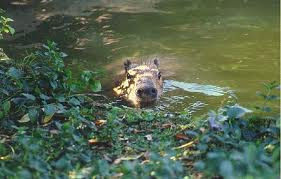Animal Wildlife | Capybara | The capybara is the largest rodent in the world, and is found inhabiting the water-logged regions of South America. Despite its large size, the capybara is in fact very closely related to other South American rodents including chinchillas and guinea pigs. The capybara is a heavy, stocky-looking animal, which grows to more than a meter in length. The capybara also has a short head in comparison to its body, and has no tail at all.
The capybara is a semi-aquatic animal that is found inhabiting marshes and wetlands throughout the South American jungle. The capybara spends much of the hot daytime hours submerged in the cooler water and the capybara has a number of useful adaptations which help it to survive more effectively in its watery world. The capybara has slightly webbed feet which help to give the capybara more stability when it is moving around on the slippery river banks, and prevents the capybara from sinking too deeply into the mud when the capybara is in the water. The eyes, ears and nose of the capybara are also situated on the top of the capybara's head, enabling the body of the capybara to be fully submerged whilst the capybara can still hear, see and smell.
The capybara looks a bit like the enormous African hippo, and behaves in a very similar way to one, as the capybara spends the hot days in the water, venturing out onto dry land in search of food under the cover of night. The capybara is a herbivorous animal and therefore only eats plants in order to acquire all of the nutrients it needs. The diet of the capybara is mainly made up of grasses and aquatic plants, along with fruits and berries and the occasional munch on tree bark.
The relatively large size and slow nature of the capybara, mean that the capybara is often a rewarding meal for hungry predators. Wildcats including jaguars, pumas and ocelots are the primary predators of the capybara along with caimans and eagles that hunt the younger ones. The capybara is also one of the best sources of food for the world's heaviest snake, the anaconda. The capybara breeds at different times of the year, depending on the region which it inhabits. Most capybara breed once a year, when a litter of four baby capybaras are born after a gestation period of around 5 months. The baby capybara are able to walk within hours of birth and remain with the mother capybara until they are a few months old.
The capybara lives in a group with between 10 and 30 other capybara individuals. The capybara remain in their large groups for safety and capybara groups have been known to contain up to 100 capybara individuals.
Tags: capybara adoption, adopt a capybara, capybara life cycle, capybara endangered, rainforest capybara, capybara rainforest, capybara leather, capybara sound, buy capybara pet, capybara sounds, capybara zoo, capybara population, capybara s, capybara games, capybara pets, capybara as pets, baby capybara, capybara pet, capybara baby, capybara steak, the capybara, stuffed capybara







0 Response to "Capybara"
Post a Comment